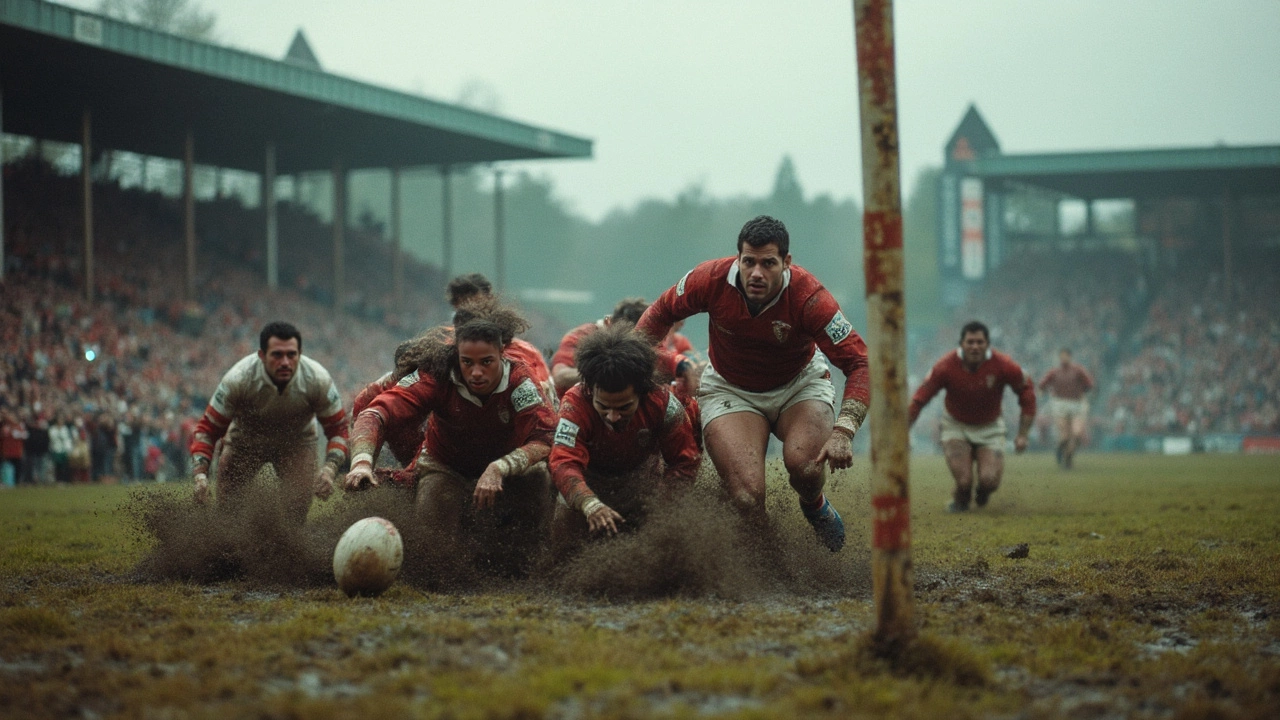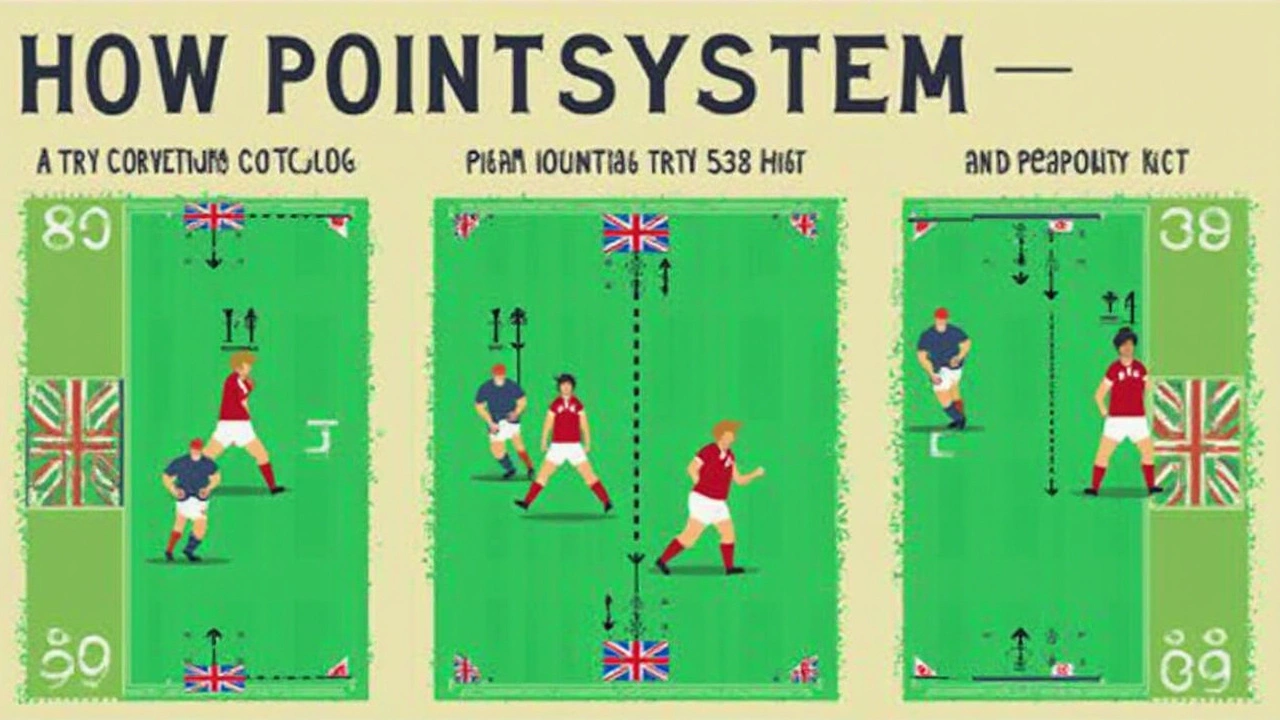What Is a Rugby Touchdown Called? Scoring Explained for Fans

If you're used to shouting "touchdown!" at a football game, rugby might throw you for a loop. The word "touchdown" just doesn't exist in the world of rugby scoring. Instead, players race across the pitch aiming to bag something called a "try." It’s not just a change of vocabulary—it represents a different way of thinking about the game. People often mix up rugby and American football, assuming they’re kind of the same. But spend two minutes watching, and you’ll realize that rugby’s rules, scoring, and even the meaning behind how points are earned are a whole different animal.
What Do You Call a Touchdown in Rugby?
If you’re fresh to rugby, hearing the players shout when they cross the line can be confusing. In rugby, the direct equivalent of a touchdown is a "try." You’ll see players dive, slide, or even tumble as they lunge to touch the ball down in the in-goal area (what football fans know as the end zone). But here’s the twist—just crossing the line isn’t enough. The ball needs to actually be pressed down to the ground with downward pressure. If the ball bobbles loose, bounces, or sits atop a hand but isn’t pressed, you don’t get your try.
Unlike American football, where body or ball placement matters, rugby is strict: the ball must meet the grass with the player’s control. This has led to some legendary photos of players outstretched at awkward angles, fingers just barely brushing the ball onto the turf. The pressure, the timing, the defense—getting a try is a big deal, and crowds often erupt in noise and excitement when it happens.
Where did the name "try" come from? It dates way back to the 19th century, when teams would "try" to score. Originally, only the kick at goal counted for points. Touching down gave you the chance, or "try," at a kick. Over time, the act of grounding the ball became valuable itself. Now, a "try" is worth five points in rugby union, and four in rugby league, as shown in the table below.
| Rugby Code | Points for Try | Conversion Kick | Other Common Scores |
|---|---|---|---|
| Rugby Union | 5 | 2 | Penalty Kick (3), Drop Goal (3) |
| Rugby League | 4 | 2 | Penalty Kick (2), Drop Goal (1) |
College rugby, women’s rugby, and youth leagues worldwide all follow this basic structure, though you might see slightly different rules in amateur tournaments. It's worth noting—if you ever hear someone shout "touchdown" at a rugby game, they're probably new to the sport.
The try is so central to rugby that you’ll hear coaches, fans, and even TV commentators constantly speculating how many tries a team might need to win. It’s the most celebrated way to score in the game. And sometimes, especially in the last wild minutes, it brings out heart-stopping drama as a team chases that bonus-point try for the win.

How Scoring Works in Rugby: Tries and More
Okay, so you know about tries. But scoring in rugby has a few more twists than just a single move. After a team gets a try—that is, they’ve grounded the ball in the opponent's in-goal area—they have a chance to pick up extra points by "converting" it. The conversion is a kick taken in line with where the try was scored, so the further out to the sideline, the harder the angle. Sink it through the posts, and that's two more points.
Besides tries and conversions, most games see teams racking up points from penalties and, sometimes, drop goals. A penalty kick is awarded for things like offside positions or dangerous play. The kicker gets a shot at goal from where the penalty occurred. Make it, and you bag three points in rugby union, two in rugby league. A drop goal—one of the sport’s most skillful party tricks—involves a quick drop kick during play. The ball must bounce before the kicker boots it between the posts. Get it through in rugby union and your team adds three points; in rugby league, just one.
Here’s a quick summary of rugby union scoring:
- Try: 5 points
- Conversion: 2 points
- Penalty Kick: 3 points
- Drop Goal: 3 points
And for rugby league:
- Try: 4 points
- Conversion: 2 points
- Penalty Kick: 2 points
- Drop Goal: 1 point
If you’re watching the Six Nations, Super Rugby, or a World Cup match, teams often weigh up whether to go for a penalty kick or push hard for a try. Sometimes, racking up penalties is the best option when the defense is tight. But spectacular games happen when a team keeps going for tries—snatching the lead with a daring move instead of settling for the sure kick.
One quirky thing: in rugby sevens (the fast, shorter format you’ll see at the Olympics or on TV highlights), tries are still king. But since games only last 14 minutes, each try can tip the game one way or the other in seconds. Players sprint, zig-zag, and try their luck from every angle. It’s non-stop, sometimes chaotic, but always entertaining.
Want to spot emerging rugby trends? Look at the number of tries teams are scoring year to year. In the 2019 Rugby World Cup, for instance, teams racked up a record 285 tries throughout the tournament. Attack-focused strategies are all the rage, with coaches finding creative ways to move the ball wide, break the defensive line, and launch wingers into space.
Lots of fans talk about "bonus points" too—these reward teams for scoring a certain number of tries in a match or losing by a small margin. It helps keep games lively, since every team has a reason to push for one more try instead of playing it safe. Understanding this is key if you want to get deep into rugby analysis or fantasy leagues.
So next time you see a wild scramble for the line, remember it’s not just a touchdown: it’s a try, and it’s only the tip of the rugby scoring iceberg.

Tips and Surprising Facts for Rugby Fans
If you’re heading to your first rugby game or just want to sound smart at the pub, here’s a crash-course in rugby scoring etiquette—and some trivia to drop on your friends:
- You don’t have to touch the ball with your whole body or arms. The law just says "downward pressure." You can even use your torso or (accidentally) your stomach—anything but your head or feet.
- Trying to ground the ball with your head is not legal, and, yes, someone once tried it.
- The fastest ever try in rugby world history? It happened after just seven seconds in a professional match. That’s barely enough time for the defense to breathe.
- In 2024, top try-scorer Duhan van der Merwe scored 10 tries in a single Six Nations championship. That’s like breaking every scoring record in the book.
- Rugby balls are oval for a reason—it makes bouncing unpredictable and tackling harder. The original balls were actually pig bladders, which is why the odd shape stuck around.
- Some rugby stadiums have sensors in the goalposts to assist with scoring controversies—yep, the game can get that high-tech!
- When you watch rugby on TV, keep an eye out for the referee making a "TRY" signal: both arms out straight, fingers pointing at the in-goal area. There’s no confusion about what’s just happened.
- The current official rugby union rulebook (published June 2025) still states: "A try is scored when a player grounds the ball in the opponents’ in-goal area." It’s that simple, but it gets argued every weekend.
Here’s a pro tip if you’re learning: when a team is close to the try line and a bunch of huge players suddenly bind together in what looks like a messy huddle, that's a "maul." Sometimes, tries are awarded after mauls if the referee can see the ball is grounded—otherwise it gets super confusing for new fans.
Wondering why the conversion kick has to be in line with where the try was scored? It’s designed to reward teams that score close to the posts—making the kicker’s job easier. Tries scored out wide mean a tougher angle, so wings who love to dive into the corner often make things tricky for kickers.
One fun rugby myth: there’s no actual "touchdown"—even though a try literally involves touching down the ball. The reason is all history. If you say "touchdown," people will nod politely, but if you say "try," you’re instantly in with the rugby crowd.
If you want to try your hand at playing, pay attention to grounding the ball—most rookie mistakes involve dropping it early or forgetting to apply pressure. Watch pro highlights and you’ll see how much focus goes into that crucial final moment.
The next time you're explaining rugby at a party, you can say: "A rugby touchdown is called a try, and it's worth five points—unless you’re watching rugby league." People might just ask for your insight at the next big game.
